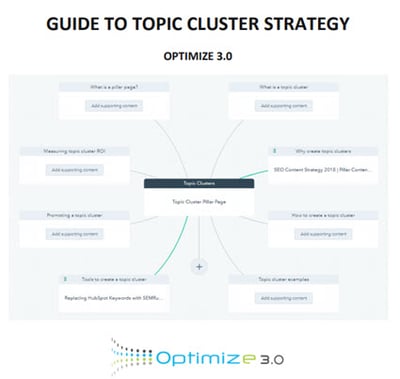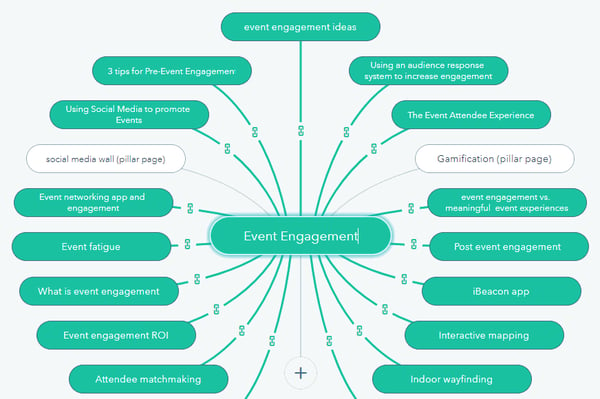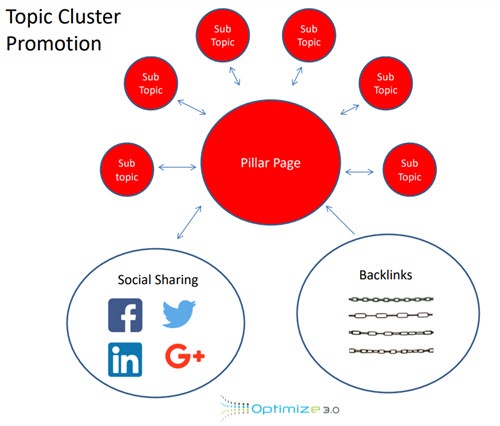Overview
seo and content is changing
More and more businesses have accepted the “content is king” mantra in recent years. But the biggest challenge of managing content campaigns persists - how do you prove the ROI of your content?
The biggest roadblock to content ROI has been the thought that simply hitting publish would lead to high rankings in Google, loads of inbound traffic, and measurable returns. Unfortunately, the path to successful SEO and content strategy haven’t been so simple of late.
But now, there’s a better way to create, organize, and measure your content.
The key is to shift your focus to topic clusters.
What are Topic Clusters?
Topic clusters are the combination of pillar pages and supporting “cluster” content pieces that are better-suited for ranking your website given the current state of SEO.
As marketers, we should be taking pages from the playbooks of top SEOs. And while we may have a grasp on yesterday’s SEO best practices, more and more top SEOs are starting to do things differently. Most notably, they include:
- Evolving beyond optimizing content and websites around exact-match keywords
- Producing comprehensive, semantic-rich content around specific topics
- Emphasizing SEO-friendly site architecture and consistent, strategic internal linking
- Aggressively promoting content through link building, repurposing, use of paid channels, etc.
All of these tactics come together to make topic clusters a successful way to approach both SEO and content strategy. And the first component of effective topic clusters is powerful pillar content.
Pillar Content and the Benefits of Ungating
A series of content pillars create a stabilizing foundation for your overall marketing strategy. Individual pillar content pieces are web pages that cover one specific topic in depth while linking to a cluster of high-quality, related content.
If this idea sounds vaguely familiar, it may be because you’ve taken this kind of approach before. In recent years, inbound marketing and content strategy have thrived on the back of valuables pieces of gated content promoted through related blog posts that drive traffic to conversion-optimized landing pages.
The main problem with this approach is that your best pieces of content remain gated behind forms. While forms have help inbound marketers generate leads for years, they aren’t exactly intuitive. Now more than ever, it’s important for our content strategies to maximize user experience—and that means ungating your pillar content.
By ungating pillar content, you unlock the added benefits of:
- Attracting more organic traffic to foundational pages
- Increasing quality conversions by pulling prospects to your highest-quality content
- Delivering user-friendly content that solves for the human visiting your page
While ungating pillar content and providing deep dives on core topics is inherently beneficial for both you and your audience, design is still crucial. Even now, 90% of website visitors prefer to read from a PDF from a web page.
To deliver the best of both worlds, create pillar content on a web page that also includes an optional form for a PDF alternative. That way, you achieve the benefits of pillar content without sacrificing user experience.
In addition to choosing between gated and ungated content, you must also decide which type of pillar best-fits your needs. There are two main types to consider:
- The 10X Content Pillar Page: The majority of these pages will consist of owned content. Think of them as ungated eBooks that live right on your website. On each page, your goal will be to dive deep on core concepts of your topic clusters. If you’re looking for an example of how this could work, check out we helped Etuma build its CX Professional’s Guide to Text Analysis.
- The Resource Pillar Page: These combine owned content with a deep library of outbound links that cover your core topic. Think of resource pillar content as bookmarkable reference pages for your audience. One example of this approach is how our customer, Townsend Security, built The Definitive Guide to Encryption Key Management Fundamentals.
These examples give you a good starting point for understanding the role of pillar content in a topic clusters approach to SEO and content strategy. There’s more to this story, though.
*Download the full Topic Cluster Guide here
Take this page with you!

Why Create a Topic Cluster?
Let’s back up for a moment and look at why topic clusters have become so important for SEO and content strategy. The trend is rooted in both changing consumer (searcher) behavior and the evolution of search engines to meet expectations. When consumers were searching simply with fragmented keyword queries, SEOs and content strategists competed in the rankings for keyword variations.
Now, we give search engines much more credit, querying Google with complex questions and expecting seamless understanding. That’s why Google introduced the Hummingbird update in 2013, its first move away from individual keywords and toward parsing phrases.
Then, in 2015, Google released the RankBrain algorithm update that brought machine learning to search. Over time, machine learning has helped search engines connect the dots of unique phrases and queries, piecing themes together and returning more accurate results pages.
Rather than going after exact-match keywords (which is becoming increasingly inefficient as keywords gain thousands of variations), it’s time to focus on creating topic clusters and keeping users engaged on site.
With topic clusters, you turn your site architecture into a simple, logical form that Google can actually crawl and understand. For each topic you choose, a pillar page acts as the definitive outline of everything readers need to know. Then, you audit your existing content and link relevant content to the pillar page or start creating new pieces that link to that pillar page. As you build out your cluster content, you can start adding links to those pieces within the pillar page itself.
By doing so, you create what HubSpot calls a “semantic relationship between the pages’ content.” That means you’re telling Google and other search engines that the pillar page is an authoritative source that should be ranked. And the more cluster content you create that bolsters the pillar page’s authority, the higher your SERP placements will rise.
With such an interwoven approach to SEO and content strategy, you would just increase inbound traffic—you’ll get your audience spending more time with your owned content start converting visitors faster. Higher engagement and lower bounce rates are increasingly important SEO factors.
So, you know what topic clusters and pillar pages are. And you know why they’re so important for SEO and content strategy moving forward. Now, we just need to talk about how to go about creating them.
How to Create a Topic Cluster
If you’re a HubSpot user, your path to high-performing topic clusters may be a bit clearer. With the platform’s Content Strategy tool, you can identify, create, execute, and measure your topic clusters all from one dashboard. But that doesn’t mean you can completely offload responsibility—it’s still up to you to make sure you’re putting together the best topic clusters.
That means first understanding that your core topic should be a broad term that follows these general guidelines:
- Between two and four words
- Industry-specific
- Educational by nature
- In support of your products/services
- Characteristic of a head keyword as opposed to a long-tail version
Once you’ve come up with the right core topic (possibly with some assistance from HubSpot), you can start to plan out your subtopics—the related pieces of content that will dive deeper into specifics of your core topic.
Subtopics can be a bit tricky, though. For all the benefits of topic clusters we’re discussing, it’s important not to forget your traditional keyword research because it comes in handy when finding subtopics. When thinking of good cluster content ideas, these sources might help:
- Google related search data
- Featured snippets about your core topic
- Your existing content about the topic
- And SEMRush, especially, can help shape your topic cluster strategy by stepping in for the keyword tracking feature that HubSpot retired
As you create the blog posts, landing pages, and web pages that will act as subtopic pieces, you have to make sure you’re creating internal links properly. Linking subtopic content to the pillar page with core-topic anchor text is what will help Google crawl through your site architecture and rank you accordingly.
There are many technical considerations that factor into SERP rankings. But above all, search engines want to know that the content you’re providing about the core topic is more valuable to readers than other pieces.
That value hinges on creating the best possible pillar page for the core topic.
SEMRush tool can help with keywords and finding sub topics (read blog post here)
Important tip: If you have an existing whitepaper or download that is gated, use this as the basis for your topic cluster. This is content that Google and other search engines have not seen. Moreover, there is a good chance this is an in-depth piece of content that can be re-purposed easily.
How a topic cluster looks inside HubSpot (below). As you can see, the supporting content is linked to pillar page and vice versa. Here's a case study about how we created this topic cluster.

Here are additional tips for creating a topic cluster content strategy.
How to Create a Pillar Page
The easiest way to create a pillar page is to think about it as if it’s an ungated eBook. But unlike your gated PDFs, you need to make sure that the pillar page is optimized for search—after all, topic clusters are an SEO strategy at heart.
To create a proper pillar page, consider the following layout/formatting/optimization tips:
- Reference the core topic in your page title
- Make sure the core topic term is in the URL
- Include top-level navigation
- Name the core topic in the H1
- Define the core topic
- Add conversion-focused landing page elements to drive action
- Create an anchor-linked table of contents
- Use H2 tags for section headers (sometimes including the core topic)
- Spread related core topic terms throughout the pillar page
- Always link to relevant internal resources using SEO-friendly anchor text
- When appropriate, include relevant links to valuable external resources
- Give readers a “Back to Top” button to improve user experience
When you finish drafting a pillar page, go back through this checklist and make sure you’ve set yourself up for success.
And if you need some inspiration, check out some of these examples of pillar pages that contribute to successful topic clusters:
- MeetingPlay’s pillar page on Event Engagement
- This Senior Providers Network page about Employee Benefits
- The Retail Doctor’s page about Retail Sales Training
- And this page you’re reading right now about topic clusters
Once you put all that work in to develop the perfect topic cluster—pillar page, subtopics, and all—you have the not-so-small task of getting people to find the content.
How Much Does a Topic Cluster & Pillar Page Cost?
Topic clusters are involved. If you don't have a whitepaper to start with, you're looking at building a topic cluster from scratch. Here's a quick breakdown of the estimated costs of creating a whitepaper:
- Pillar page template $300-$500. This is a unique template with several features including a floating Table of Contents with jump links to the page sections.
- Pillar page content. To be effective a pillar page should run from 2,500 to 3,500 words. Assuming you are paying a a good writer that will cost about $.25 per word. That's about $750 to $1,000 for the content.
- Pillar pages need to link to at least 4-6 supporting blog posts. Each of those will be 400 to 600 words so that's another $750
All in, your out of pocket costs will run about $2,250. Keep in mind you still have to build out the topic cluster strategy and your time needs to be factored in as well.
If your looking for someone to assist with creating topic cluster content, check out nDash they have a unique platform that integrates with HubSpot.
Also, get a $100 credit towards your next content piece with the coupon code "optimize".
Promoting Topic Clusters
Have you heard about content marketing’s dirty little secret? Here it is—production follow promotion, not the other way around.
Usually, marketers consider a 50/50 content production to content promotion ratio effective. In reality, the best marketers have a ratio closer to 20/80. The greatest pillar pages and subtopics in the world won’t deliver ROI for your business if no one reads them.
That’s why promoting topic clusters is so important, both with short-term goals and long-term goals in mind. As you seek success in the short-term, these tactics will drive traffic to your pillar pages and subtopics:
- Create an email series about your new topic clusters and send it to your subscriber list
- Upload relevant emails to your Facebook page and start building a look-alike audience
- Break up the content into snippets and use them to write a series of promotional social posts
- Reach out to people who have linked to similar pieces of content
- Go on Quora and answer at least 5 questions relevant to your topic clusters
- Comment on 5 relevant blog posts from authoritative websites
We all want to publish content and watch it become a hit right from the start. Those short-term tactics will help, but you also need to think of what you can do to help your topic clusters deliver compound value in the long-term. Strategic, long-term tasks include:
- Build real relationships with influencers in your industry
- Start contributing on industry newsletters
- Write guest blog posts on authoritative websites
- Get active within industry communities
- Amplify your highest performance content on social
- Launch a remarketing ad campaign to keep visitors engaged
- Syndicate your content on relevant websites/platforms
- Update and expand your top-performing content to increase audience value
- Repurpose content for new formats
- Continuously add content to your topic clusters to bolster authority

Summary
Marketers have always been told that their path to SEO success relied on finding relevant keywords with high search volume and medium/low competition. That may have worked in the past, but keywords are no longer king for SEO and content strategy.
Search engines are treating consumers like real people and it’s time we started doing the same with our content. That means creating, organizing, and measuring our content in ways that truly put the audience first. Topic clusters do just that with a focus on simple site architecture and educational content.
When your short-term tactics and long-term strategic efforts are aligned, you’ll start to see your pillar pages climb the ranks of SERPs. And once you’ve climbed the ranks, you can earn your share of the 92% of searchers that never get past Page 1 of Google. That’s when you’ll start seeing direct ROI from your content campaigns.
Start creating your topic clusters today and work on getting more traffic with less content. Get ahead the next evolution in SEO and content strategy.



